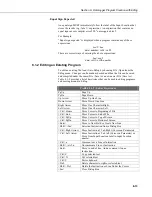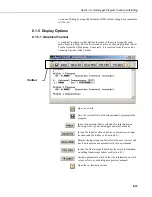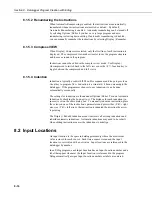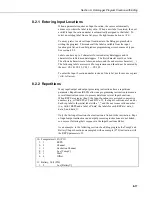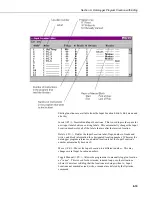
Section 8. Datalogger Program Creation with Edlog
Maximum number of routers
- Enter the number in the PakBus
network, including the PC.
While it is possible to calculate the exact number of nodes, neighbors, and routers
in a PakBus network, it is often advisable to build in some “room to grow”. For
example, you might want to add 3-4 nodes, neighbors and routers. Be aware that
each device you add means the datalogger must allocate memory for its routing
table, so if you add too many, the datalogger won’t have enough memory left to
run its program.
8.4.6.2 Beacon Intervals
This option is used to set the interval on which the datalogger will transmit a
beacon out a particular port to the PakBus network. Use the drop-down list
box to select the port over which the beacon will be transmitted, and enter the
desired interval in the Communications Interval field. This option is the same
as the datalogger's *D18 mode.
In some networks, a beacon interval might interfere with regular
communication in the PakBus network (such as in an RF
network), since the beacon is broadcast to all devices within
range. In such cases, it may be more appropriate to use the
Neighbor Filter instead, which broadcasts a beacon only to those
dataloggers which it has not received communication from
within a specified interval.
NOTE
8.4.6.3 Neighbor Filter
This option allows you to list expected neighbors that are available to the
datalogger in the PakBus network. The datalogger will attempt to issue a
"hello" command to all the dataloggers listed in the neighbors filter list, and
will transmit an expected communication interval. The communication
interval is the interval on which the datalogger expects to receive
communication from the neighbors. If communication is not received from a
neighbor within 2.25 times this interval, then the datalogger will attempt to
issue another "hello" command to that datalogger only (thus, creating less
network traffic than the Beacon Interval).
The expected interval is entered into the Communication Interval field in
seconds. The neighbors are defined by entering their addresses into the table.
A range of addresses can be entered by using the Swath field. For example,
entering 1 for the address and 5 for the swath will set up dataloggers with
PakBus addresses 1, 2, 3, 4, and 5 as neighbors to the current datalogger. This
option is the same as the datalogger's *D19 mode.
8.4.6.4 Allocate General Purpose File Memory
PakBus dataloggers have the ability to store files transmitted from an NL100 in
a general purpose memory area. This memory area is configured as ring
memory. A value can be entered to specify the number of 64K blocks of
memory that should be used for this purpose. Final storage memory will be
reduced by the amount of memory specified in this option. This option is the
same as the datalogger's *D16 mode.
8-26
Summary of Contents for PC400
Page 2: ......
Page 16: ...Section 1 Introduction 1 6...
Page 18: ...Section 2 System Requirements 2 2...
Page 46: ...Section 4 The PC400 Main Screen 4 24...
Page 49: ...Section 5 Split 5 3...
Page 82: ...Section 5 Split 5 36...
Page 114: ...Section 6 View 6 14...
Page 132: ...Section 7 Short Cut Program Generator 7 18...
Page 188: ...Section 9 Datalogger Program Creation with CRBasic Editor 9 30...
Page 230: ...Appendix B Table Based Dataloggers B 12...
Page 249: ......


